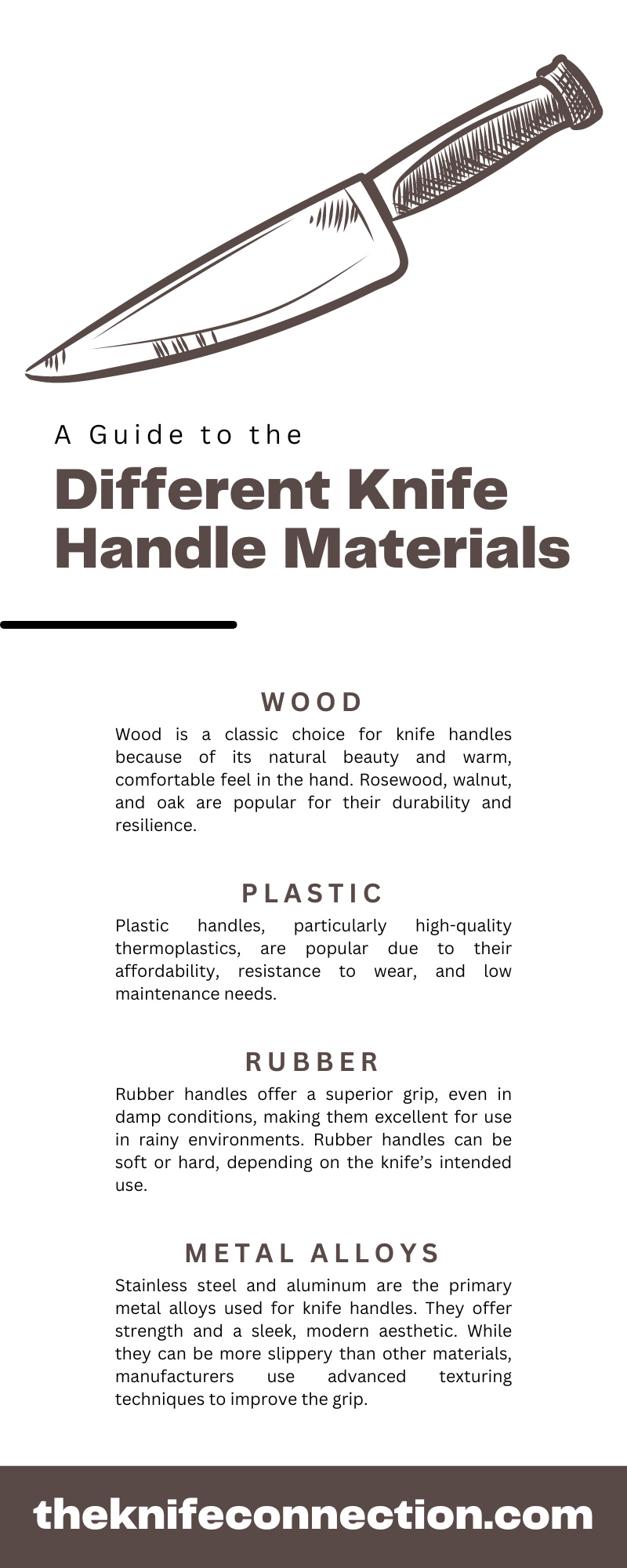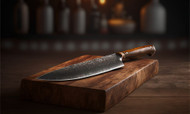A Guide to the Different Knife Handle Materials
Apr 18 2024 - 10:39
A knife handle might just be as crucial—if not more so—than the blade itself. Many people understand that the right handle can determine the comfort, safety, and even the aesthetic pleasure of using a knife. What makes a handle right for you? We’ll walk you through our comprehensive guide to the various knife handle materials so that you can choose the best one for your needs.
Common Knife Handle Materials
It should come as no surprise that knife makers use many different materials for crafting handles. However, some are more common than others. In this section, we’ll cover some of the most common materials for knife handles.
Wood
Wood is a classic choice for knife handles because of its natural beauty and warm, comfortable feel in the hand. Rosewood, walnut, and oak are popular for their durability and resilience. However, they require more care than synthetic options to prevent drying, cracking, or warping.
Plastic
Plastic handles, particularly high-quality thermoplastics, are popular due to their affordability, resistance to wear, and low maintenance needs. Some popular plastic options include Zytel® and polypropylene, which are known for excellent water resistance and aging durability.
Rubber
Rubber handles offer a superior grip, even in damp conditions, making them excellent for use in rainy environments. Rubber handles can be soft or hard, depending on the knife’s intended use. Generally speaking, hard rubber is a bit more resilient, while soft rubber provides enhanced comfort.
Metal Alloys
Stainless steel and aluminum are the primary metal alloys used for knife handles. They offer strength and a sleek, modern aesthetic. While they can be more slippery than other materials, manufacturers use advanced texturing techniques to improve the grip.
Specialized Knife Handle Materials
These common options might not cut it for you. Enter the less conventional and more specialized handle materials, which provide great performance and a glimpse at the best knife crafting available.
Micarta
Micarta, a composite material made from fiberglass, has great stability and grip, even when wet. Many people find it favorable in mildly corrosive, high-performance environments, like when boating in salt water.
G-10
G-10 is a high-pressure fiberglass laminate known for its toughness and lightness. It’s similar to Micarta but has different properties, such as increased strength. This material is popular for tactical and utility knives, where durability and weight are significant considerations.
Carbon Fiber
Carbon fiber is an ultralight yet incredibly strong and corrosion-resistant material. It is very popular in industries where performance is non-negotiable, including knife manufacturing. Knives with carbon fiber handles are often associated with high-end collectibles or professional tools.
Care and Maintenance Tips for Different Handle Materials
Just as the blade requires care to maintain its sharpness, the handle material will need attention to ensure longevity. Now that you’re familiar with the different types of knife handle materials, it’s time to learn how to care for and maintain yours.
Wood
To maintain a wooden handle, keep it clean and avoid prolonged exposure to water. Oil the handle periodically with mineral oil to prevent drying or cracking. Additionally, store your wooden-handled knife in a dry area to avoid potential moisture absorption from the air.
Plastic
Plastic handles are known for few maintenance requirements. Simply clean them with a mild soap and water solution, steering clear of harsh abrasives that could scratch the surface. Avoid exposing plastic handles to UV rays for prolonged periods in order to maintain their appearance.
Rubber
Washing rubber handles with soapy water and a soft sponge is best. Thoroughly dry the handles to prevent the growth of mold and extend the material’s lifespan. Similar to wood handles, you’ll want to store rubber-handled tools in a well-ventilated area to prevent moisture buildup.
Metal Alloys
Cleaning metal handles is easy with a damp cloth and mild soap. After cleaning, dry them completely to prevent water spots or tarnishing. To maintain a metal handle’s shine, consider occasionally applying a metal polish.
Specialized Materials
Most specialized handle materials demand unique care. Always adhere to the manufacturer’s guidelines for cleaning and maintenance to preserve the integrity of these rare materials. Regular inspections and care can retain the beauty and functionality of knives with unique handles.
Factors To Consider When Choosing a Knife Handle
Selecting a knife handle material may take time. Your preferences and the purpose of your knife will dictate your choice. We’ll cover the main factors you should think about.
Comfort and Ergonomics
The handle should feel natural and comfortable in your grip; it should feel just right, even after extended periods of use. This is largely up to personal preference, so try out various materials to determine what feels best. Pay close attention to the ergonomics of the handle to ensure it fits your hand perfectly and provides the support you need for the intended tasks.
Weight
The weight of the handle plays a significant role in determining the knife’s balance. Opting for lightweight handles, like plastic, can offer the precision and control you desire for your tasks. Conversely, heavy handles, typically made of metal or wood, lend stability. This is particularly beneficial when tackling demanding cutting jobs that necessitate additional support. By carefully considering the handle weight, you can tailor your knife choice to suit a variety of cutting needs.
Intended Use
Will you be slicing through fresh game, whittling a piece of wood, or using your blade for cutting rope on the job? How you use your knife influences the handle material you choose. For instance, a survival knife intended for rugged outdoor use could benefit from a durable rubber or synthetic handle, providing a secure grip. However, a simple wooden handle might feel better in the pocket of an EDC user. It all depends on how you plan to use your knife!
Aesthetic Considerations
While function should be the primary concern, there’s no denying the satisfaction that comes from a well-crafted handle that complements the blade. If you don’t like the look of your knife, you’re much less likely to use it. That’s why you should shop at The Knife Connection! We have a wide variety of knives in stock, plus knife handles for sale. You can finally update that old knife instead of entirely replacing it!

